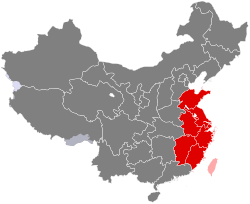"Chinese region" redirects here. For regions of the Republic of China (Taiwan), see Regions of Taiwan. For other uses, see China (disambiguation) § China-related regions, polities, and concepts.
See also: Administrative divisions of China
An editor has determined that sufficient sources exist to establish the subject's notability. Please help improve this article by adding citations to reliable sources. Unsourced material may be challenged and removed. Find sources: "List of regions of China" – news · newspapers · books · scholar · JSTOR (October 2023) ( Learn how and when to remove this message ) |
| Administrative divisions of China |
|---|
Analogous county level units Management areas Management committee |
Analogous township level units Management areas Management committee Farms area (Overseas Chinese Farm Region [ zh ]), Prison area, University towns, etc. |
(Grassroots Autonomous Organizations) Villages · Gaqa · Ranches Residential Committees |
History: before 1912, 1912–49, 1949–present Administrative division codes |
This is a list of traditional top-level regions of China.









